

Andrew Maclean
2025 Honda Accord e:HEV RS vs Toyota Camry SL: Spec Battle
3 Months Ago
Mercedes-AMG's latest sports sedan may not match the BMW M5, but it presents a strong case against other large German performance saloons.
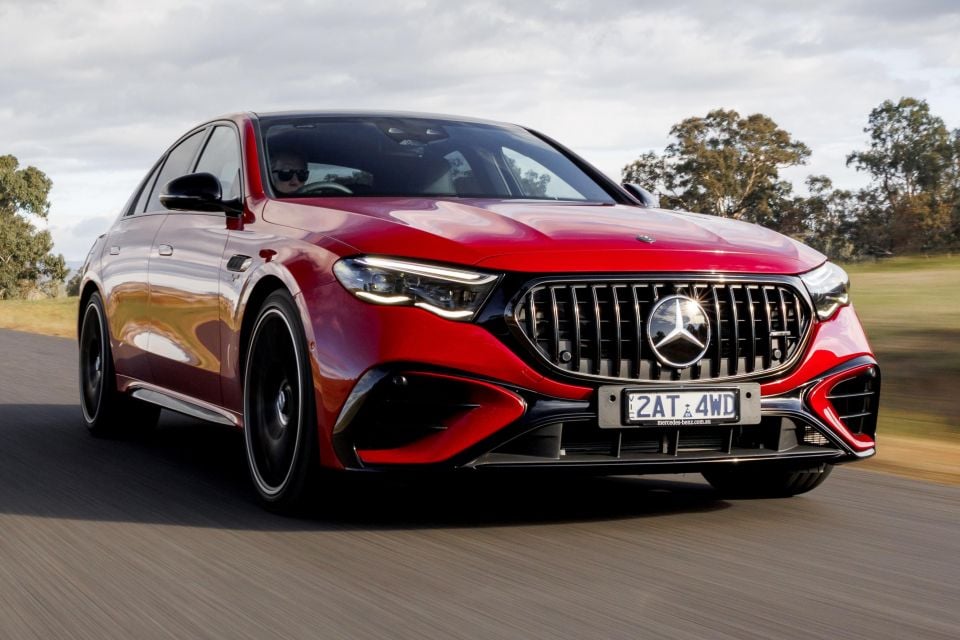
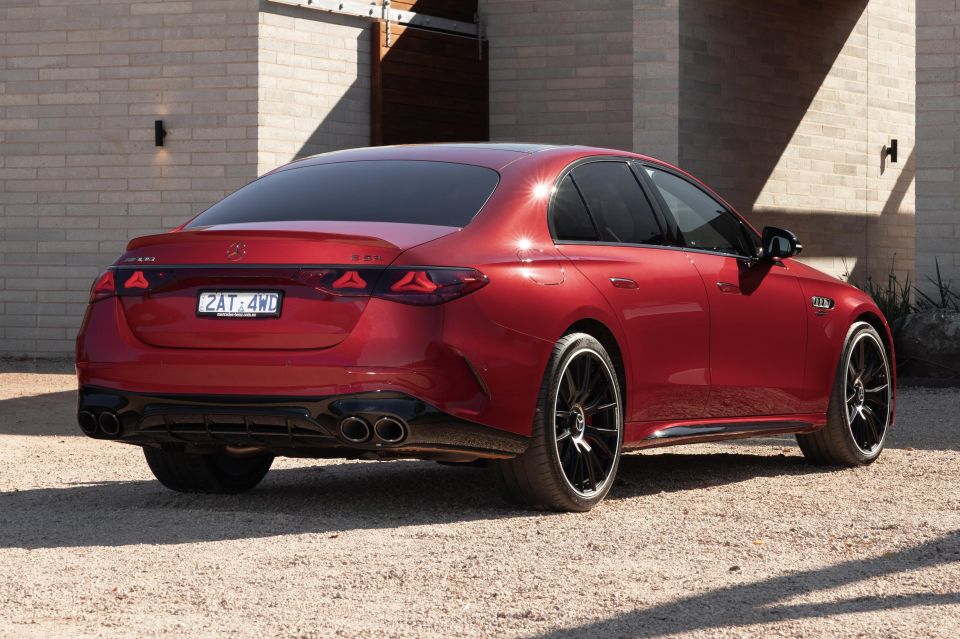

Marketplace Journalist

Marketplace Journalist


Marketplace Journalist

Marketplace Journalist
Where expert car reviews meet expert car buying – CarExpert gives you trusted advice, personalised service and real savings on your next new car.
If you like the latest Mercedes-Benz E-Class but want a lot more performance – courtesy of a bigger electrified six-cylinder powerplant – the Mercedes-AMG E53 might well be your ideal ride.

Take the already attractive and luxurious presentation of the latest sixth-generation E-Class sedan first revealed in 2023, then combine it with Mercedes-AMG’s tradition of amping up engine and chassis performance to make everything move as fast as it can, and you get the new E53 Hybrid.
The key talking point here is the beefed-up plug-in hybrid (PHEV) powertrain, which is new for the latest W214-series large German executive sedan. With more than 100kW of power and nearly 500Nm of torque on tap, the electric motor alone is capable of convincing you this is a reasonably fast four-door.
But it’s paired with the real beating heart of the E53: a turbocharged 3.0-litre inline six-cylinder petrol engine, which – when everything’s charged and working harmoniously – can propel the E53 from zero to 100km/h in a claimed 3.8 seconds, which not hanging around by any measure, let alone for a big luxury sedan.
It’s also blisteringly quick for a car that’s as heavy as this is, but there’s also a lot going on under the sheet metal to make sure the car can handle it, including adaptive suspension and even adaptive engine mounts.
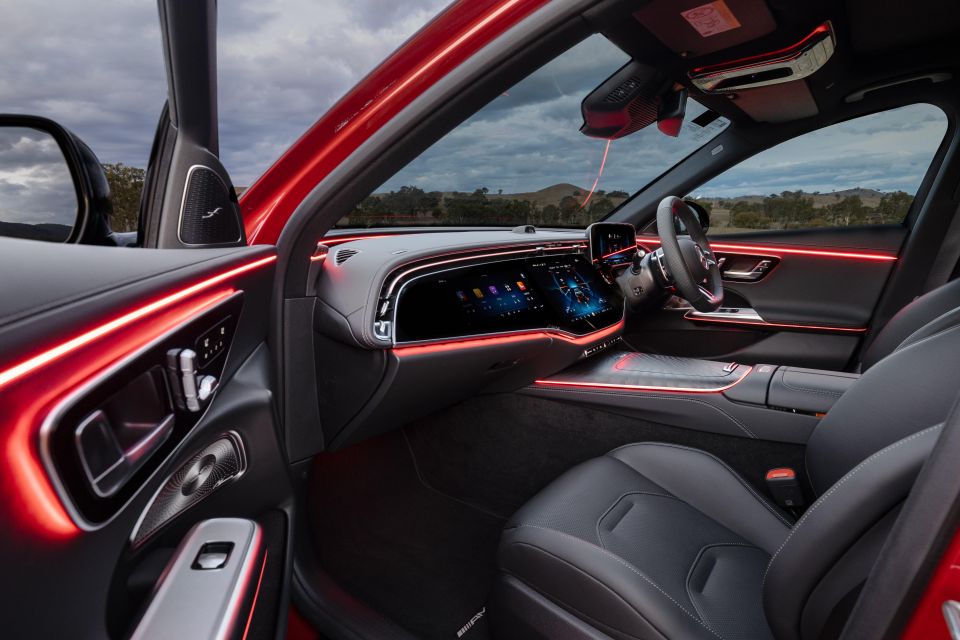
The E53 is undoubtedly a niche car, however, with minimal direct rivals let alone those with a PHEV powertrain. Lines could be drawn between the BMW M5 and the larger Porsche Panamera E-Hybrid, but they’re both more expensive and likely to attract a different audience.
We’re still waiting for Mercedes-AMG’s new E63, a model that’s long been the arch-enemy of the M5. In the meantime, the E53’s closest rival is therefore the Audi S6, but unlike its toned-down A6 counterpart it hasn’t been revealed with PHEV power just yet.
The S6’s twin-turbo petrol V6 is capable of pushing it from zero to 100km/h in 4.5 seconds, but the Ingolstadt brand’s large sports sedan is also significantly cheaper than the E53. A more tantalising comparison would almost certainly come with an S6 PHEV.
Is the E53 Hybrid capable of wearing the many hats AMG has thrown at it, or has it missed the mark? We tested the Stuttgart brand’s big new electrified performance sedan at its local media launch in Victoria to find out.
There’s only one variant of the new Mercedes-AMG E53 sedan, and it’s priced at $199,900 before on-road costs.
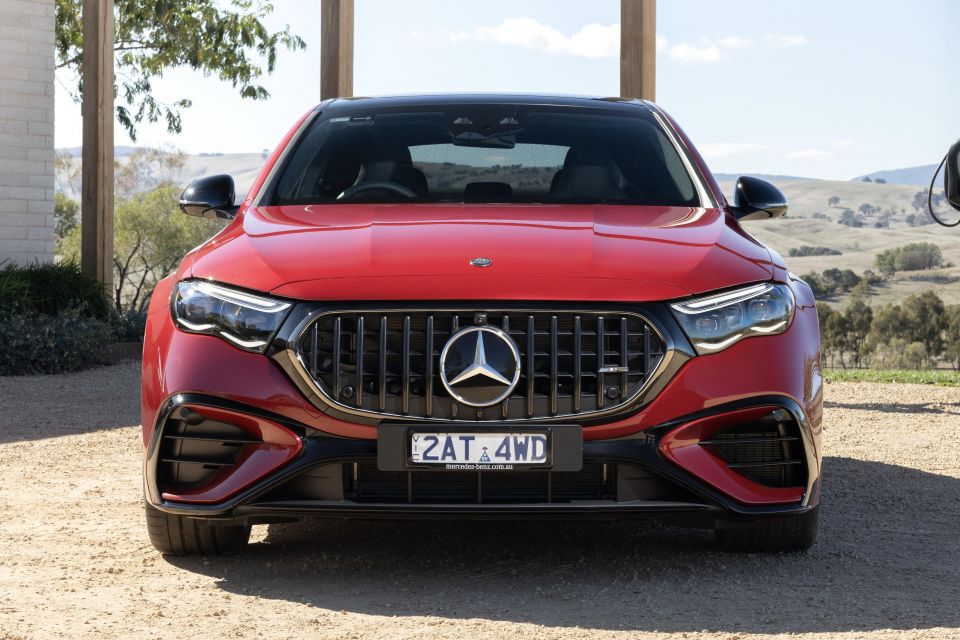
| Model | Price before on-road costs |
|---|---|
| 2025 Mercedes-AMG E53 Hybrid 4Matic+ | $199,900 |
That makes it roughly $30,000 pricier than its most direct rival in the Audi S6 quattro, priced at $168,015 before on-road costs.
There’s also a looser connection with the M5 and the Panamera E-Hybrid, which are both large luxury PHEV sedans. The M5 is quicker and sharper without being significantly more expensive at $259,900 before on-roads, while the Panamera E-Hybrid is larger and starts at $268,100 before on-roads.
Even more distant rivals could include fully electric German four-doors like the Audi e-tron GT for around $200,000 depending on the variant, and the BMW i4 M50 for roughly $130,000 before on-roads, neither of which are leagues away in terms of size.
Mercedes-AMG is also offering an Edition One variant of the E53 at launch, adding a claimed $29,900 worth of extra accessories.
To see how the Mercedes-AMG E53 stacks up against its rivals, use our comparison tool
Buy your new car without the stress. It's fast, simple and completely free.

Great service from Travis and team, second time I have used this business would not hesitate to recommend them to anyone
Craig C.
Purchased a Ford Ranger in Sunshine Coast, QLD
CarExpert helped Craig save $7,224 on his Ford Ranger, now let us save you on your next new car.
Get your BEST priceUnbelievably screen-heavy, even by modern standards.
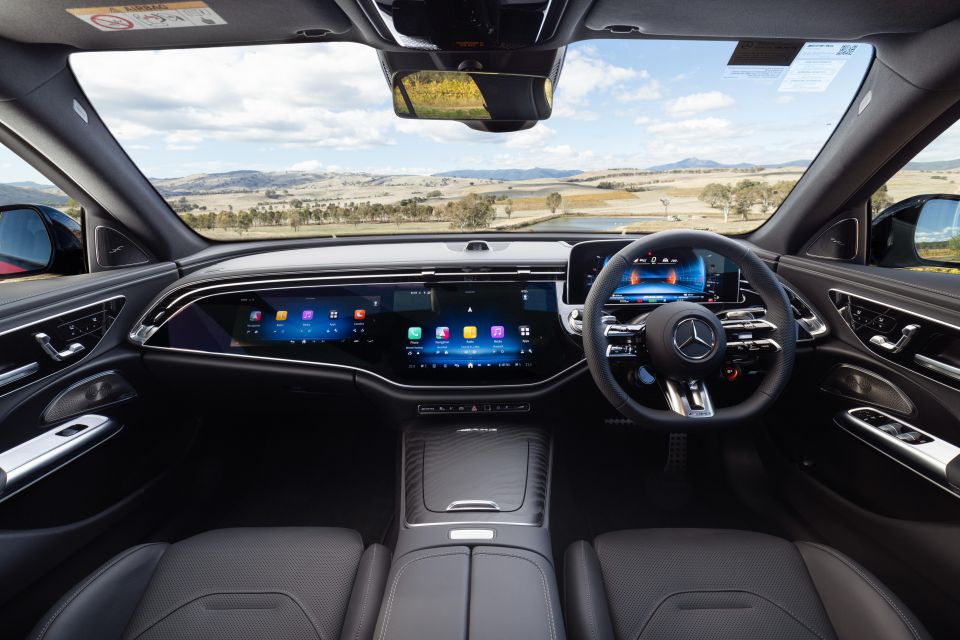
In case you somehow missed it, the E53’s drawcard is that colossal full-width digital panel on the dashboard. It’s shared with the standard E-Class, and dubbed the MBUX Superscreen by Mercedes-Benz.
It combines two 12.3-inch screens – a driver’s instrument cluster and a front passenger display – with a third, 14.4-inch unit in the middle for infotainment and vehicle settings.
Visually, it’s hardly complicated and reminiscent of similar setups in some other Mercedes models, but it is different from the MBUX Hyperscreen found in the EQE because it isn’t recessed into the dashboard. Moving from left to right, the passenger’s screen allows for functions like music and video playback, and also supports Bluetooth headphone connectivity.
It’s invisible to the driver when in Reverse or Drive too, thanks to light-directing tech designed to minimise distraction. A bonus for all passengers is Mercedes’ so-called ‘4D audio’, which incorporates a high-end Burmester sound system linked to seats that vibrate bass frequencies – with varying intensity.
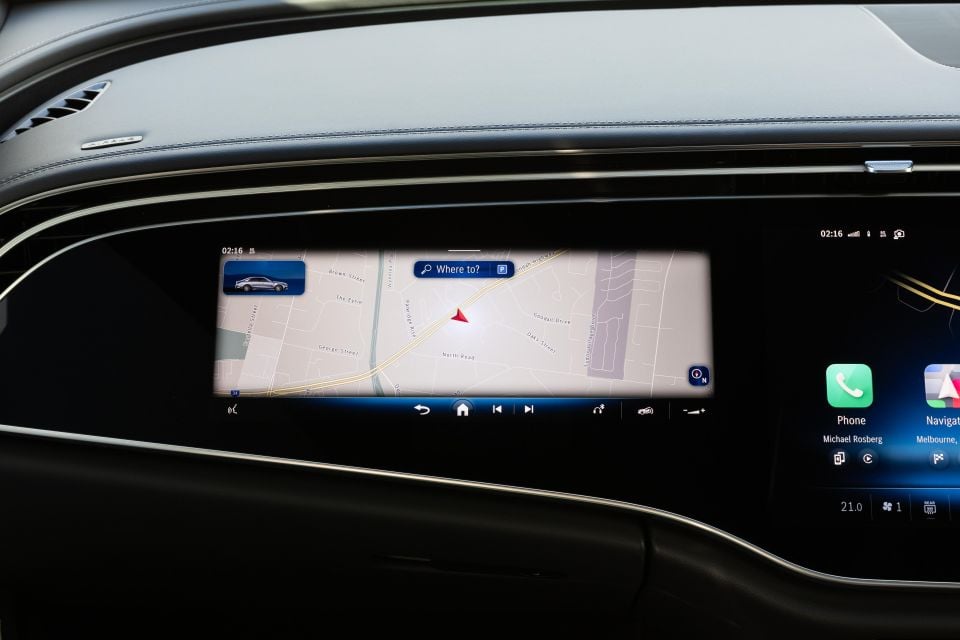
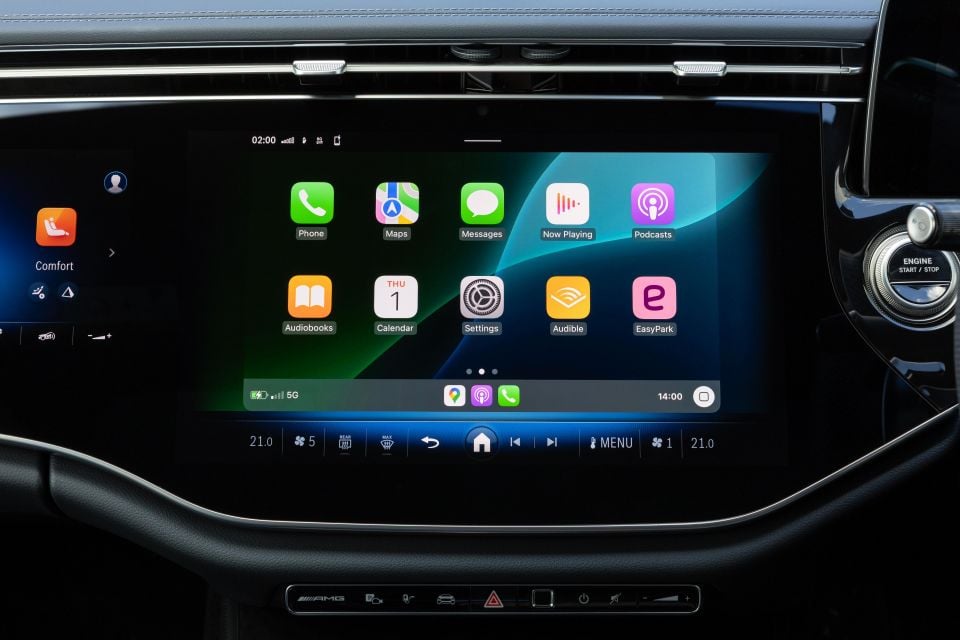
In the middle is the multimedia heart of the E-Class interior. Here you’ll find basic apps like satellite navigation, and it’s also where you operate Apple CarPlay and Android Auto smartphone mirroring – both of which via wired and wireless connectivity.
Diving through here will also reveal vehicle settings to adjust all sorts of items, including but not limited to interior ambient lighting, specific suspension and power tunes, and climate control. Unfortunately, there are no physical buttons for the latter, which is instead operated via the ‘always-on’ ribbon at the bottom of the screen.
It’s not an ideal setup and can be finicky to work with on the move. Pressing a function like temperature will open a dedicated climate menu, which can also overwhelm you with the amount of controls you’re then presented with.
There’s plenty more to be found here with some time spent flicking and pressing. The same can be said for the instrument display, which also offers a plethora of information and customisation options.
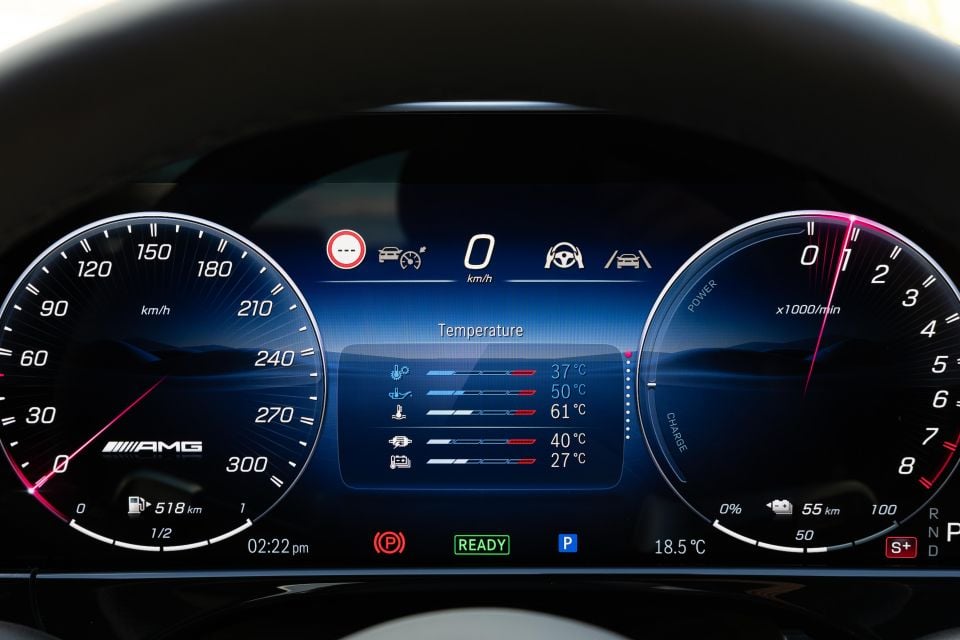
The buttons on the right-hand side of the steering wheel allow the driver to flick through various displays and themes on not only the instrument cluster, but also the head-up display above.
Both of these displays are crisp and relatively easy to decipher, and of course the instrument screen can show all sorts of vehicle info like temperatures and levels. We did find that a few of the head-up display interfaces were obnoxiously large and blocked a lot of the view ahead, particularly the motorsport-esque ones with a big rev counter.
Between the driver and the instrument cluster is a chunky, leather-wrapped steering wheel. It’s practically identical to the tillers in most modern Benzes, but its large diameter seems appropriate for a car of this stature.
The material it’s finished in is also high-quality, and it’s nice to hold. But we don’t love the use of haptic controls on its horizontal spokes, as some of our directional swipes sometimes went astray.
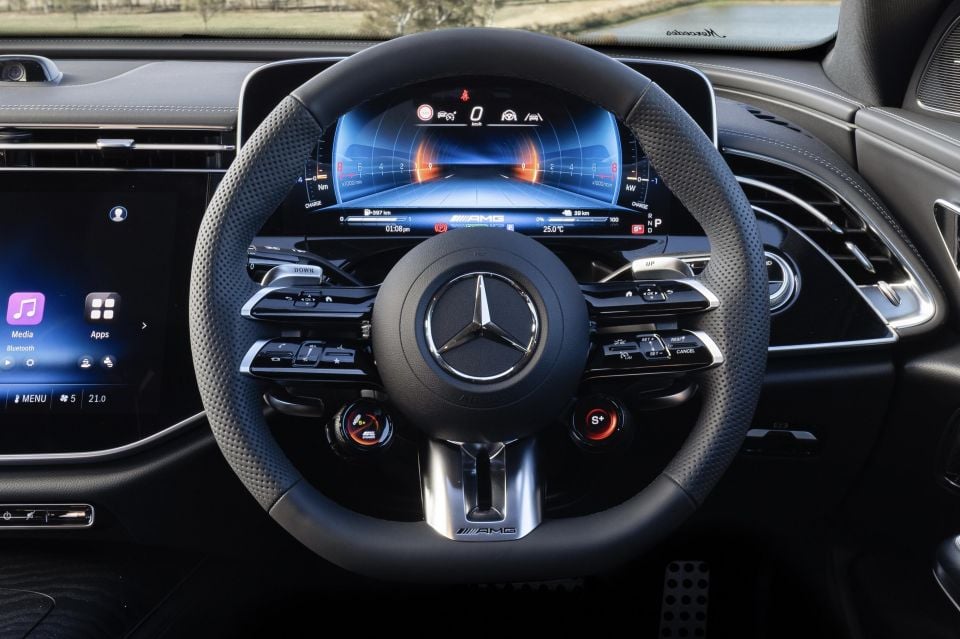
We also found the positioning of the instrument display and steering wheel awkward in the context of the rest of the dash, particularly because the main Superscreen panel is sleek while the driver systems jut out haphazardly.
Ergonomically it all works, however, and the electric adjustment for both the steering wheel and seats helps with this. Our testers were fitted with optional AMG Performance Seats (borderline sports buckets), which are heavily bolstered but incredibly firm.
While these seats make sense for the car’s performance applications, they’re far too firm to be comfortable on long drives. This was especially evident when jumping out of the front seats and straight into the back, where the rear bench gets the same soft cushioning as the E53’s standard front seats.
We at least appreciated the level of adjustment here, as you have electric lumbar support and side bolstering control. Going for these seats means you do miss out on some creature comforts like a massage function, but we don’t expect that to be a dealbreaker for many.
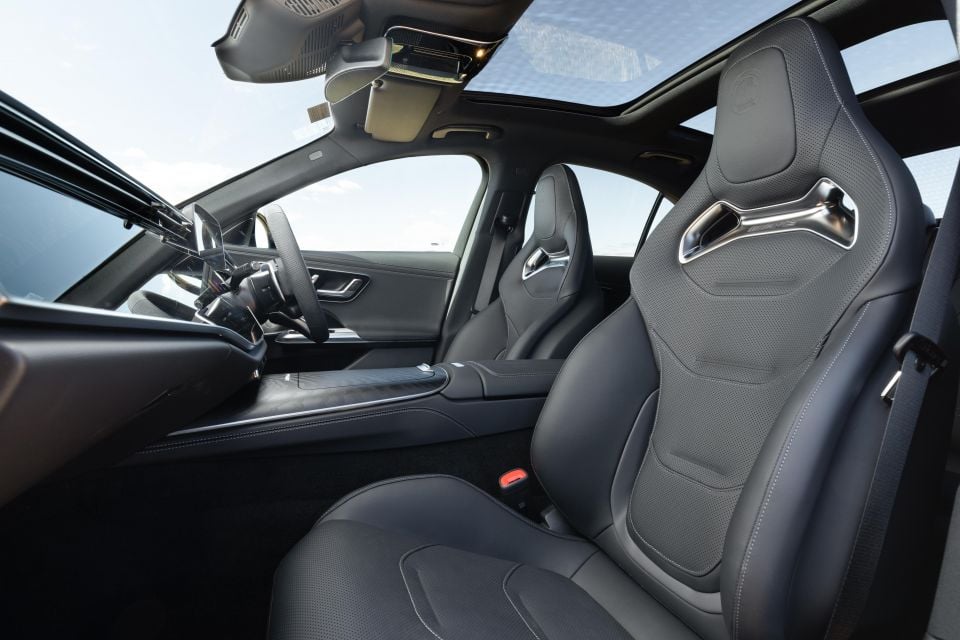
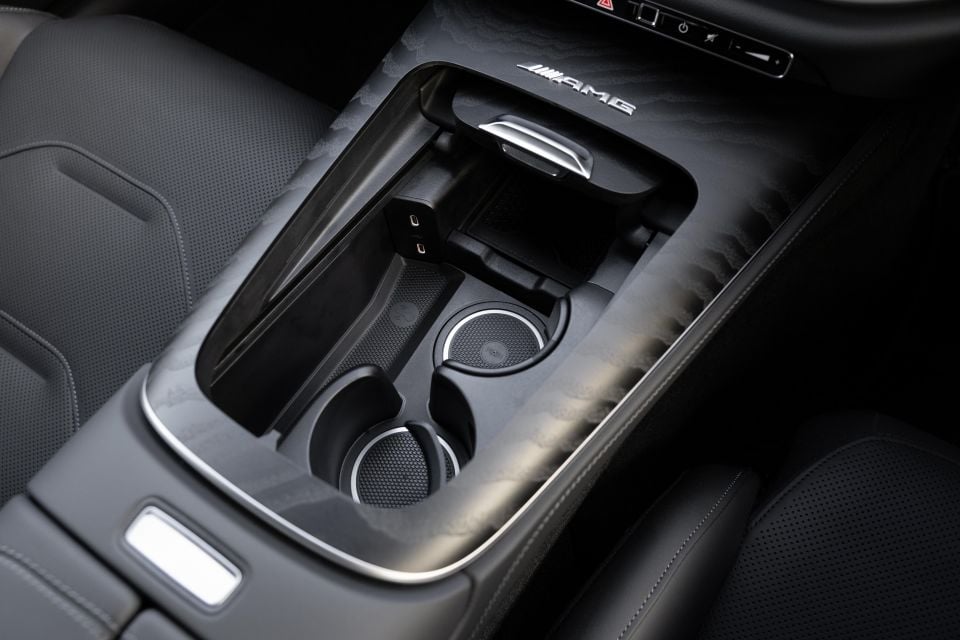
Elsewhere up front, most of the switchgear works with a solid action, especially those two circular selectors on the steering wheel.
You also get two cupholders, two USB-C ports and a wireless charging pad under the central sliding panel, along with another USB-C port and a generous amount of storage in the centre console bin.
Moving to the back reveals a space that’s more compromised than you’d expect, as is the case with the standard E-Class. This is disappointing given the exterior proportions of the car, and it just feels a touch too closed-in.
Headroom is fine as the E-Class’ roof height remains relatively high towards the rear of the car, but it’s legroom that isn’t quite at the level we’d like. Those sitting behind tall drivers will feel cramped, while foot space across the floor is hindered by a sizeable driveline tunnel.
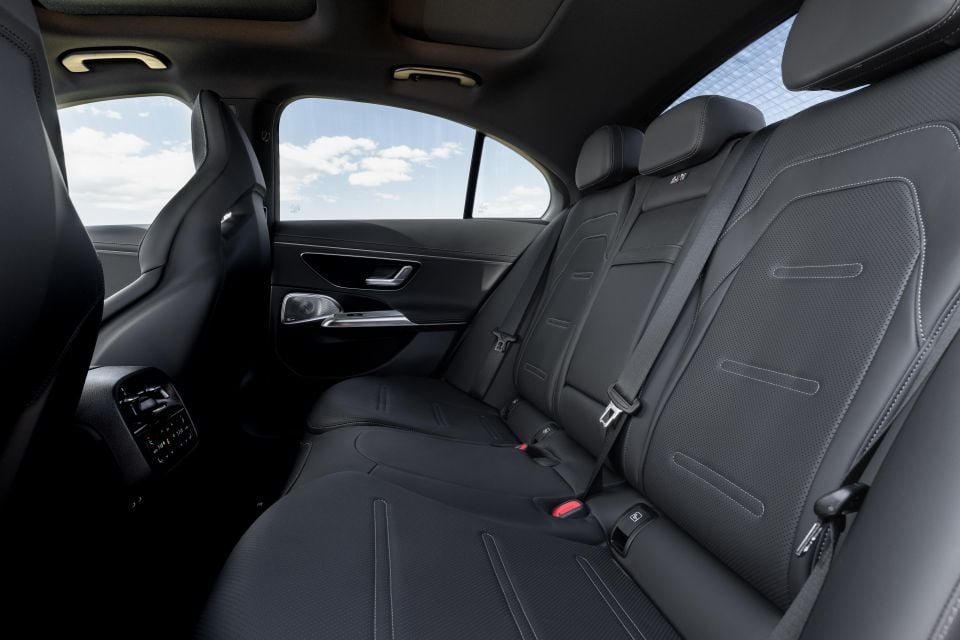
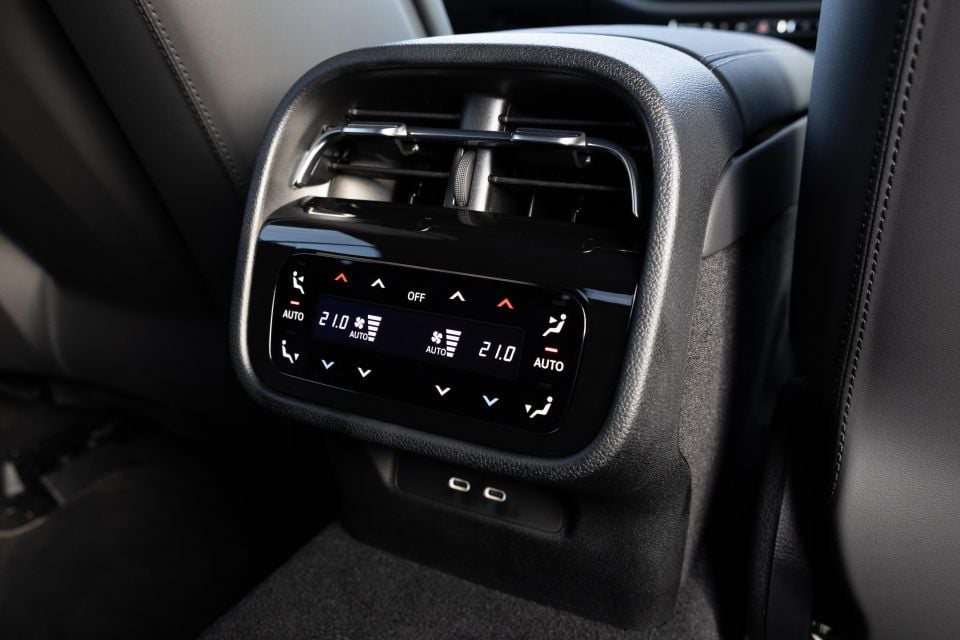
Still, the rear seats themselves are comfortable enough, especially in the context of the front AMG seats as mentioned.
You also get a dedicated climate control panel on the back of the centre console, which features more of those haptic controls as up front. It’s nice to have – even if it’s just about non-negotiable in a car that costs this much – but it will quickly attract smudges and fingerprints. Like many cars of its ilk, it’s the same with the glossy surfaces up front.
Other rear-seat niceties seem sparse at first, with no obvious cupholders for a start.
There is a fold-down centre armrest that’s well-padded, which features a dull black plastic strip along the front. Pressing this will pop out a temporary-looking cupholder arrangement, which isn’t all that dissimilar to something you’d find up front in a Ford Ranger ute, which isn’t quite what we’d expect for $200,000.
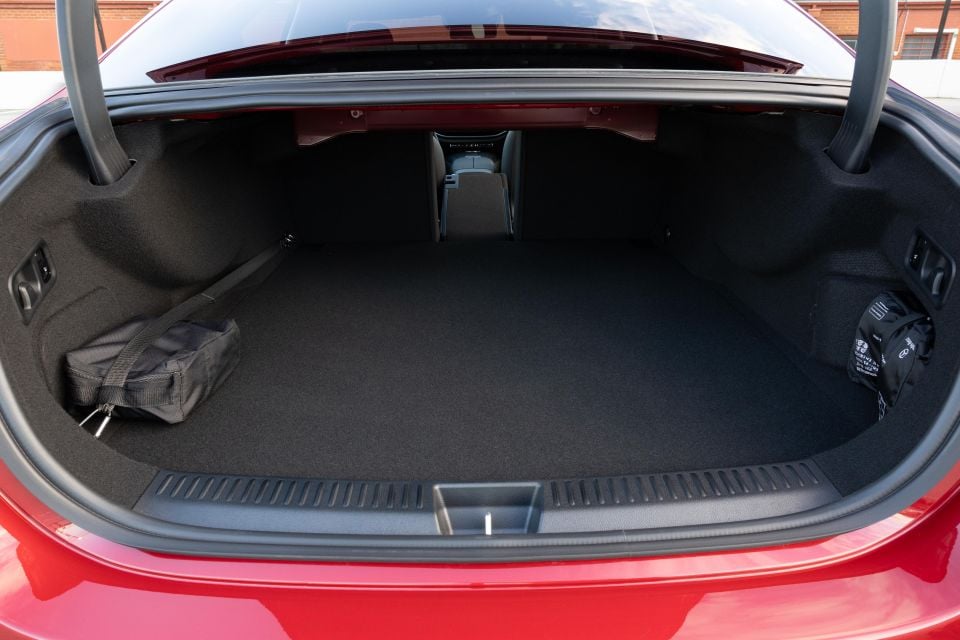
That’s another theme with the interior of the E-Class, as it’s just a little too plasticky – particularly with its steering wheel stalks. Build quality wasn’t quite up to scratch in the car we drove either, as there was a strange buzzing in the front of the cabin that we couldn’t quite pinpoint.
Sure, there are nicer elements like the leather steering wheel trim and woodgrain finish up front – or carbon-fibre if you opt for that – but the E53 cabin feels somewhat let down by the copious glossy surfaces and other less inviting items like those rear cupholders.
Mercedes-Benz quotes a boot capacity of 370 litres, which isn’t massive for a sedan this size. But you do get a generous opening and a floor that seems to stretch forward forever, and while you’ll have to lift items up and over the boot sill, at least it’s comfortably low.
On either side of the cargo compartment are two switches to drop the rear seatbacks, which gives you a bit more space for longer items. You can also drop only the centre seat if you still need to use the outboard pews.
| Dimensions | 2025 Mercedes-AMG E53 |
|---|---|
| Length | 4961mm |
| Width | 2065mm |
| Height | 1472mm |
| Wheelbase | 2971mm |
| Cargo capacity | 370L |
To see how the Mercedes-AMG E53 stacks up against its rivals, use our comparison tool
For the E53, AMG ditched the 2.0-litre four-cylinder mild-hybrid turbo-petrol engine in the E200 and E300, and instead crammed in a lusty turbocharged 3.0-litre straight-six petrol engine, plus a powerful electric motor.
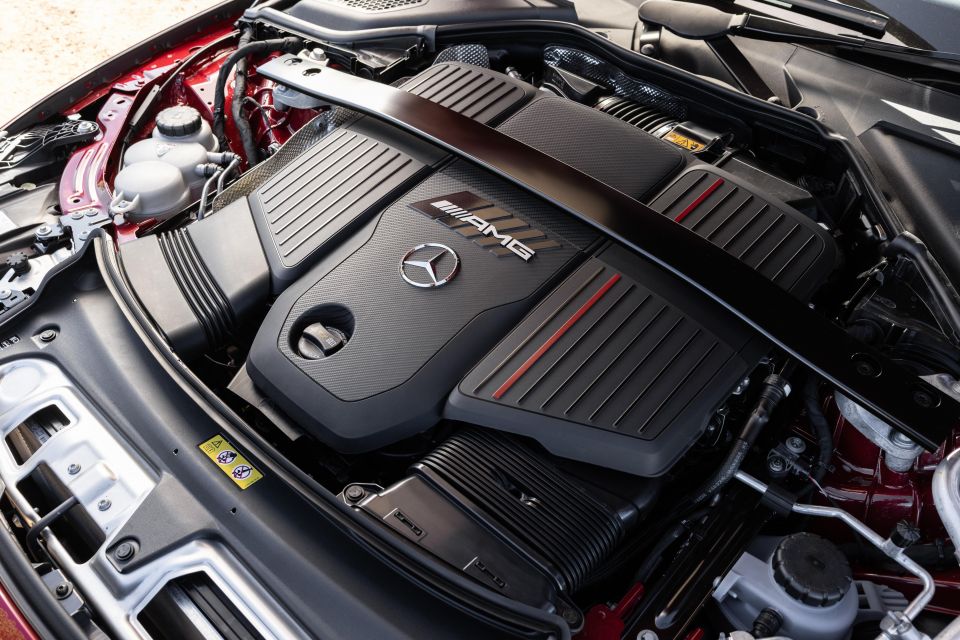
| Specifications | 2025 Mercedes-AMG E53 Hybrid 4Matic+ |
|---|---|
| Engine | 3.0L I6 turbo-petrol PHEV |
| Engine outputs | 330kW/560Nm |
| Electric motor outputs | 120kW/480Nm |
| System outputs | 430kW/750Nm (450kW in Race Start mode) |
| Battery | 28.6kWh (net), 21.22kWh (useable) li-ion |
| Transmission | 9-speed automatic |
| Drive type | All-wheel drive |
| Tare mass | 2382kg |
| 0-100km/h (claimed) | 3.8s (in Race Start mode) |
| Fuel economy (claimed) | 1.7L/100km |
| Fuel economy (as tested) | ~5.5L/100km |
| Electric driving range (NEDC) | 100km |
| Fuel tank capacity | 50L |
| Fuel requirement | 98-octane premium unleaded |
| CO2 emissions | 38g/km |
| Emissions standard | Euro 6 |
| Max. AC charging rate | 11kW |
| Max. DC charging rate | 60kW |
Though our drive route didn’t provide an extended real-world demonstration of the E53’s everyday capabilities, we saw a fuel economy of roughly 5.5L/100km after driving through Melbourne’s south-east suburbs and up to the foothills of the Victorian High Country.
We also had the opportunity to cycle through the multitude of drive modes, including the electric-only setting.
To see how the Mercedes-AMG E53 stacks up against its rivals, use our comparison tool
Like an E-Class on steroids, but not quite with the level of brutality AMG is best known for.
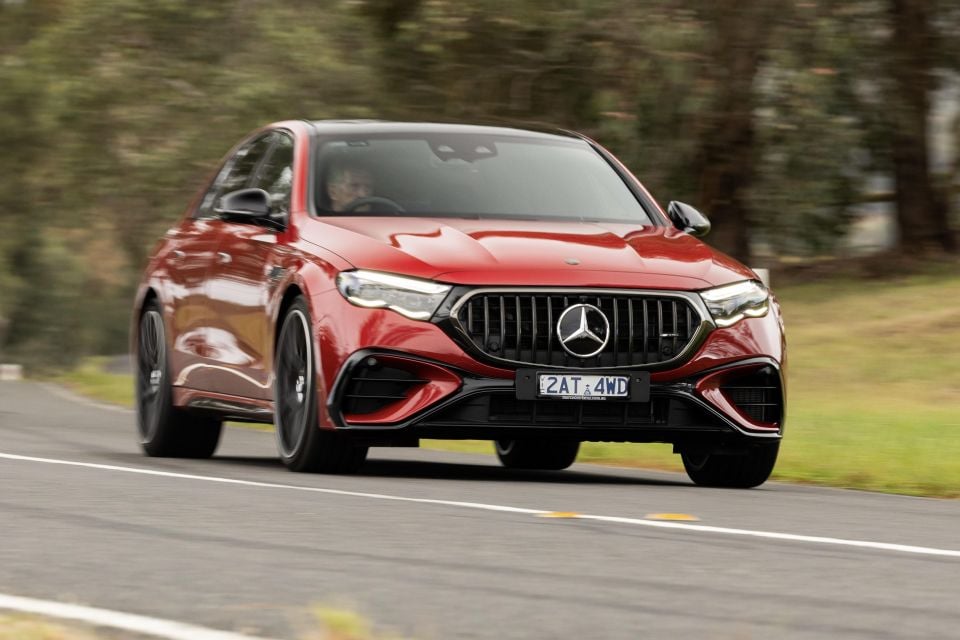
And that’s exactly what you’d want for a car that isn’t necessarily touted as a giant-killing high-performance super sedan.
It makes even more sense when you consider the E53 costs ‘just’ $70,000 more than the E300 sedan, which offers two fewer cylinders, one less litre of displacement, a decent-sized battery and plug-in capability. The difference in power output alone could well be more than enough justification for some.
A 50 per cent larger engine in a full-blown PHEV powertrain is nothing to sneeze at, and the E53 benefits greatly as a result. It also gets a sizeable battery and a solid electric-only range, along with a series of other goodies to keep you interested.
Let’s start in electric-only mode, as we did on the local launch. Like a typical electric vehicle (EV), the big E53 will start up with little more than a few clicks and whirrs as everything gears up to go, after which you’ll be able to set off in complete silence.
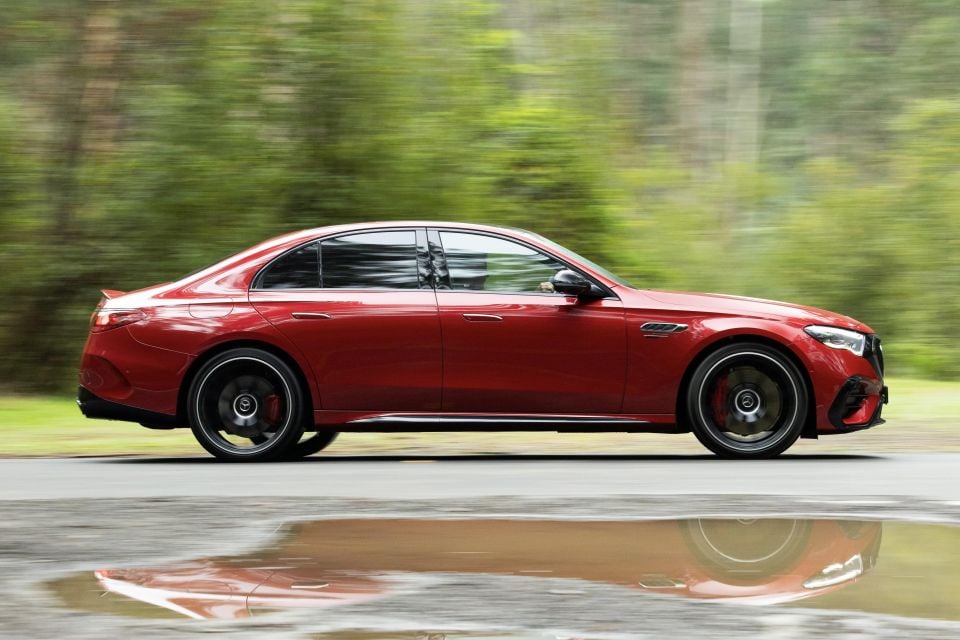
Where expert car reviews meet expert car buying – CarExpert gives you trusted advice, personalised service and real savings on your next new car.
Unlike EV modes in other hybrids, the E53 can travel as an EV at speeds of up to a whopping 140km/h – though it won’t get there nearly as fast as it will when also using the combustion engine. But the electric motor’s 480Nm of torque alone still rewards lead-footed drivers with a sturdy shove in the back.
In this mode, the combustion engine will only fire up if you plant the throttle, or if the battery charge is low. If so, the dashboard will throw up a warning and you’ll be prevented from driving in zero-emissions mode.
You can also charge the car’s battery on the move, and the same steering wheel paddles that change gears in Sport mode can also be used to adjust regenerative braking intensity – but there’s still no full one-pedal driving capability. This is only available when either battery-hold or EV-only mode is selected.
Fortunately, having the hybrid assistance mitigates the complaints we had with the E300 and its transmission’s somewhat clunky low-speed behaviour.
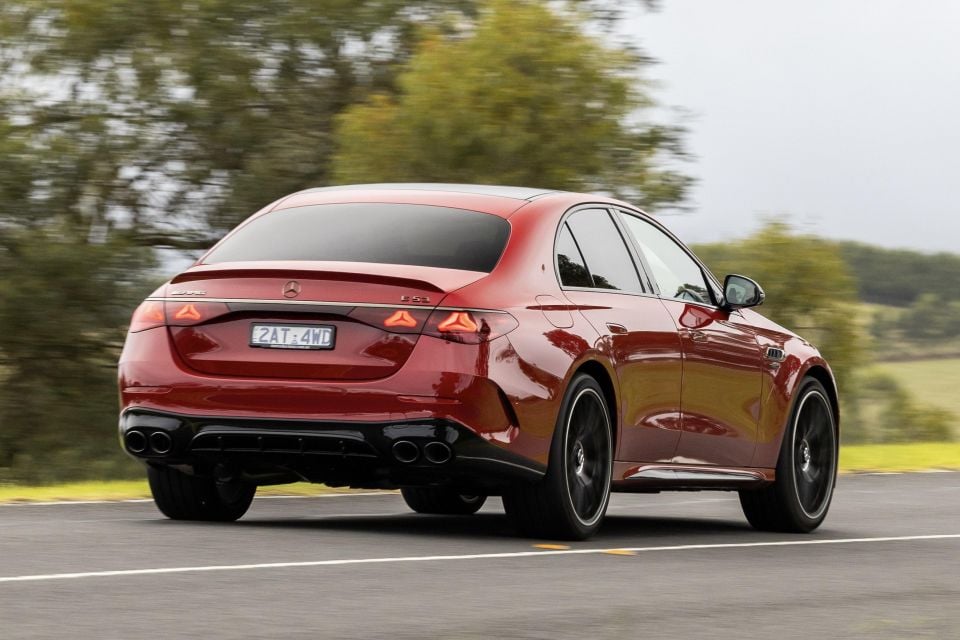
Still, prioritising EV driving will drain the battery quickly. In fact, upon getting into another E53 halfway through our drive, we found the battery was completely empty after about 75km – 25km short of Mercedes’ NEDC claim.
Comfort mode is the most ‘normal’ setting for the E53, and likely the one owners will spend most time in. This balances between petrol and electric power to give you the smoothest drive possible without too many frills.
Sport mode sharpens things up by prioritising the engine with some electrical assistance, while also stiffening up the car’s adaptive shocks. You’ll also notice a significant pickup in throttle response, while the transmission is also adjusted to provide snappier shifts.
Sport+ is where everything gets thrown at the wall, with full power from both the engine and the electric motor. The suspension is at its stiffest here, while AMG’s unique adaptive engine mounts also become more rigid, prioritising chassis performance over refinement.
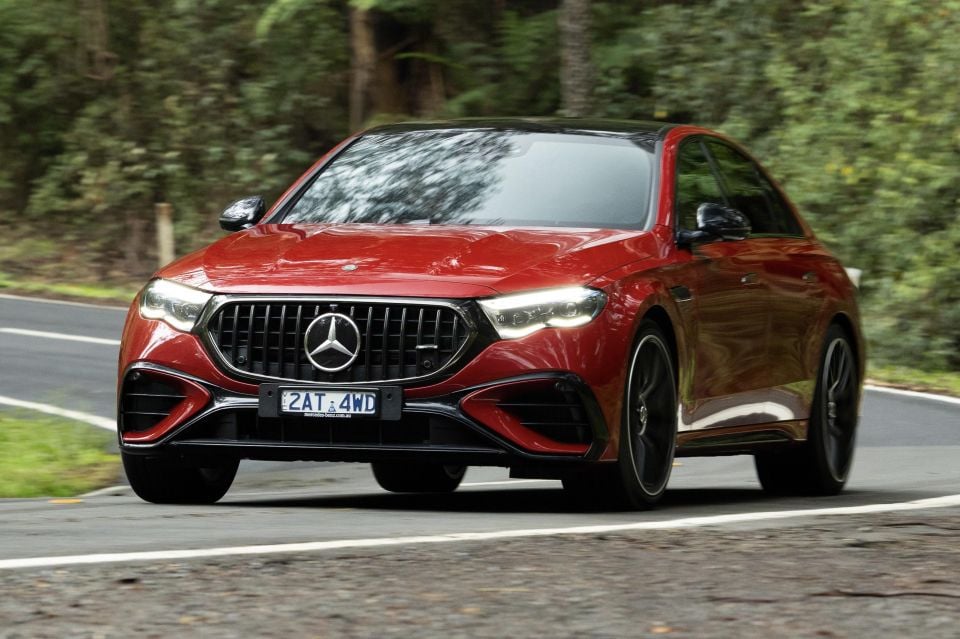
In practice there’s a slight difference there, but not to the point where every interior fitting shakes loose. It’s these fine touches that give AMG’s influence on the E-Class life and energy, not so much the interior.
As expected, the low-profile tyres, large alloy wheels, and stiff suspension result in a fair bit of road noise inside the cabin, particularly on coarse-chip surfaces. This is worse in cars fitted with the optional 21-inch alloys.
It’s forgivable as the E53 is a luxury sports sedan first and foremost, not a long-distance cruiser. But that does raise the question of exactly who it’s aimed at, given the standard E-Class is arguably better suited to long-haul commuting or road-tripping.
In Australia, where road quality is questionable in many areas and speed limits too low where the roads are good, this car really can’t stretch its legs. Because of how planted it feels, we’d expect the E53 to be perfectly suited to the speed limitless freeways of its home country.
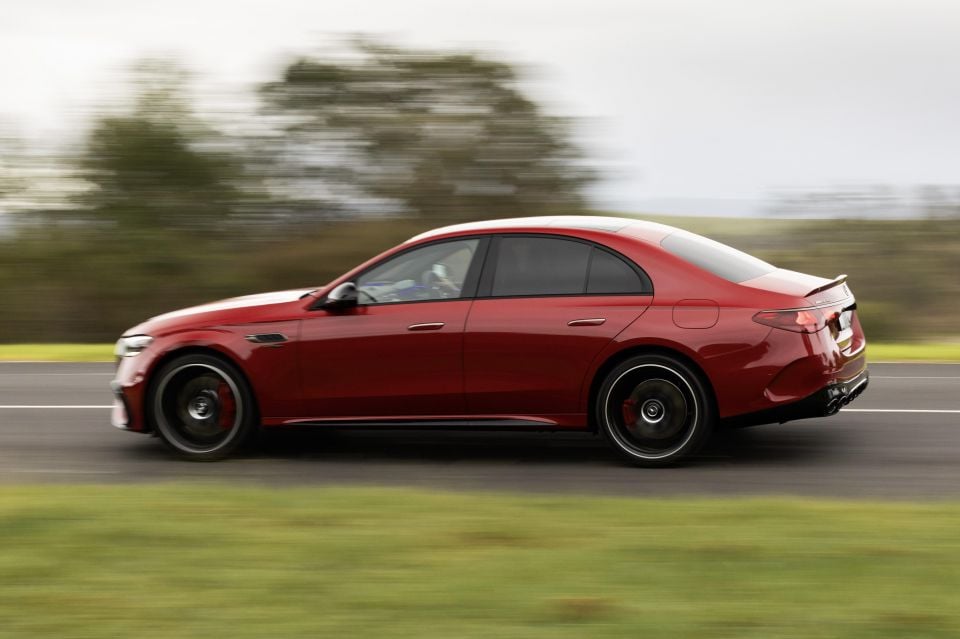
Regardless, it’d almost certainly be easier to live with when equipped with the softer standard seats. The combination of the hard AMG Performance Seats and the firm adaptive suspension – even in comfort mode – will probably be a little much for many.
Where this car shines is in the twisties, which is probably what AMG had in mind for non-German markets, even if that’s a fairly niche use case. And the E-Class chassis provides a strong foundation for AMG to build upon.
Crank the dial up to Sport+ and everything comes alive. You’ll notice a fair bit more engine noise, though most of it is fake and played through the speakers. Look closely at the car’s rear and you’ll see the exhaust outlets aren’t quite real.
What isn’t fake is the E53’s handling dynamics, despite weighing well over two tonnes. It can rotate on a dime at low speeds thanks to its rear-wheel steering, although taking sharper turns too fast will induce some understeer.
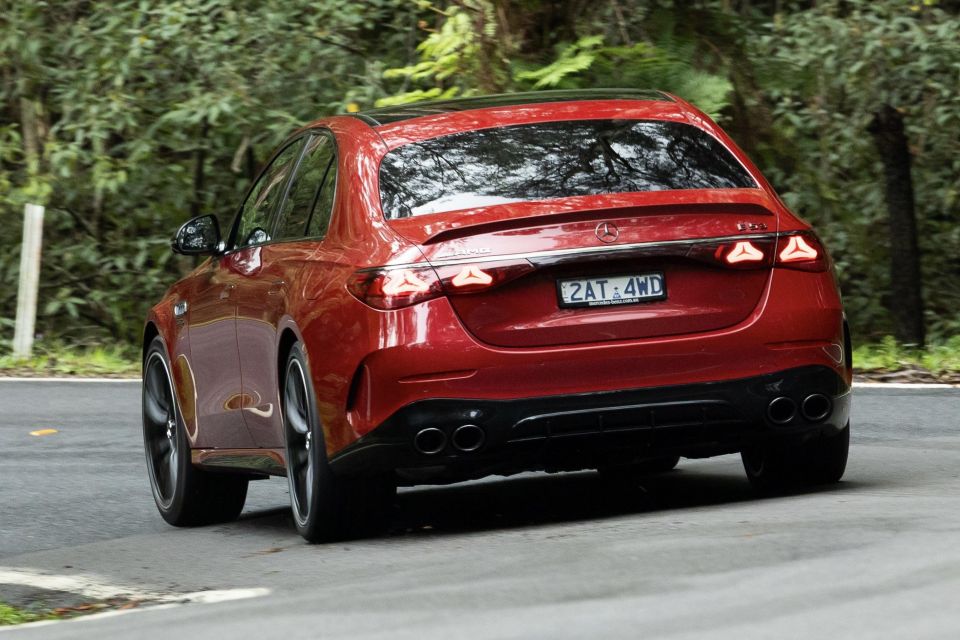
There’s just enough feedback through the seat and steering wheel to know exactly what the car is doing under you, and you’ll struggle to break rear-end traction in any meaningful way thanks to its 4Matic+ all-wheel drive system – even if it is rear-biased.
You will notice some tyre squeal as the fronts grapple to keep the E53 in check around those tight bends, but for the most part it feels glued to the road. Also solid are the car’s upgraded brakes, which take a moment to get up to temperature but bite aggressively once there.
That’s a good thing for a car like this, as managing weight was a big part of what AMG needed to accomplish in order to make it feel enjoyable and not unwieldy. It still feels heavy under hard cornering though, and not quite as nimble as we’d like during quick direction changes.
It’s on the open road where the E53’s high-speed stability and road holding really come into their own. Australia just doesn’t have the roads to fully exploit this.
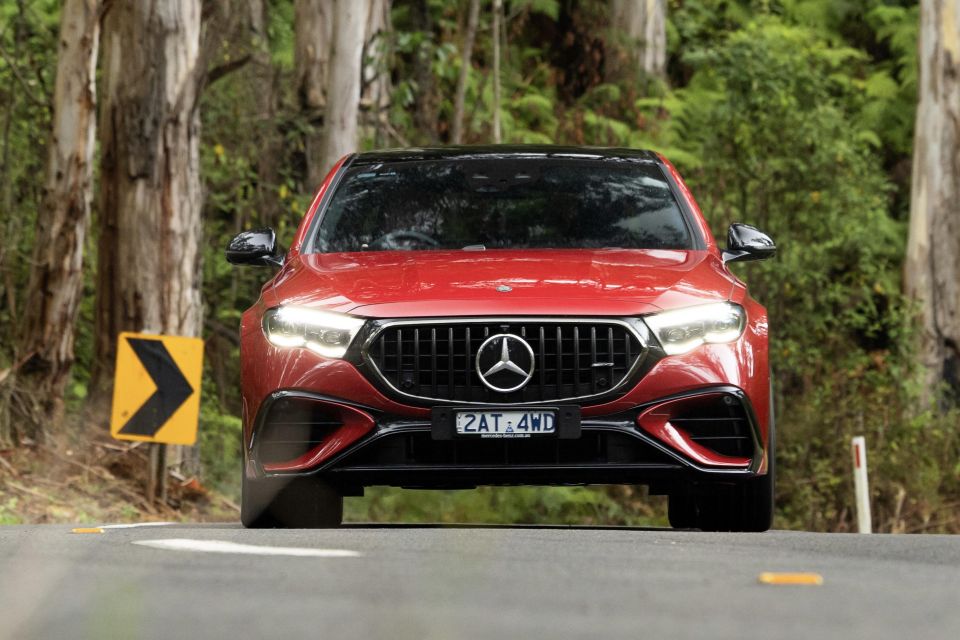
And there’s no question about this big sedan’s powertrain performance. Planting the throttle away from an intersection can activate the stability control to minimise wheelspin. That’s seriously impressive for an all-wheel drive car, and speaks to the mountain of torque on tap here.
There’s very little torque steer when doing so too, which is evidence of the AWD system’s rearward bias and more proof this car isn’t geared towards comfort, which is where its Benz-branded siblings have the edge.
As with the regular E-Class, the E53 is loaded with tech. The screens are one thing, but there’s a strong suite of assistance systems that make the car easy to drive in normal traffic.
On the highway you can make use of its adaptive cruise and lane-centring systems, which work well when the road is dominated by sweeping bends and predictable movements. You can also use this on rural roads to an extent, though the car is hesitant to crank on significant steering lock on its own.

This is where rivals like the 5 Series have it beat, as the big Beemer can confidently steer itself around tighter bends at speed, as can many Audis. We were impressed by the E53’s ability to stay centred on straight roads with no edge markings though.
There’s speed sign recognition, but the car won’t beep at you for exceeding the posted limit by a kilometre or two. It will beep if you’re indicating in the direction of a car alongside, which is annoying if you’re turning across a multi-lane intersection in parallel.
As mentioned, the four-wheel steering helps with manoeuverability at low speed, while the array of sensors and cameras helps to position the car in tight spots despite its long bonnet.
Visibility out of the cabin is good too, with a decently sized rear window and good sight lines over the shoulder for quick head checks when necessary.
All up, AMG’s E-Class chassis and powertrain upgrades significantly improve the E53’s handling and acceleration performance, for a price that seems justifiable. But its real advances are only fully realised at higher speeds, so it all seems a bit of a waste in a country like Australia.
To see how the Mercedes-AMG E53 stacks up against its rivals, use our comparison tool
There’s only one version of the Mercedes-AMG E53 available.
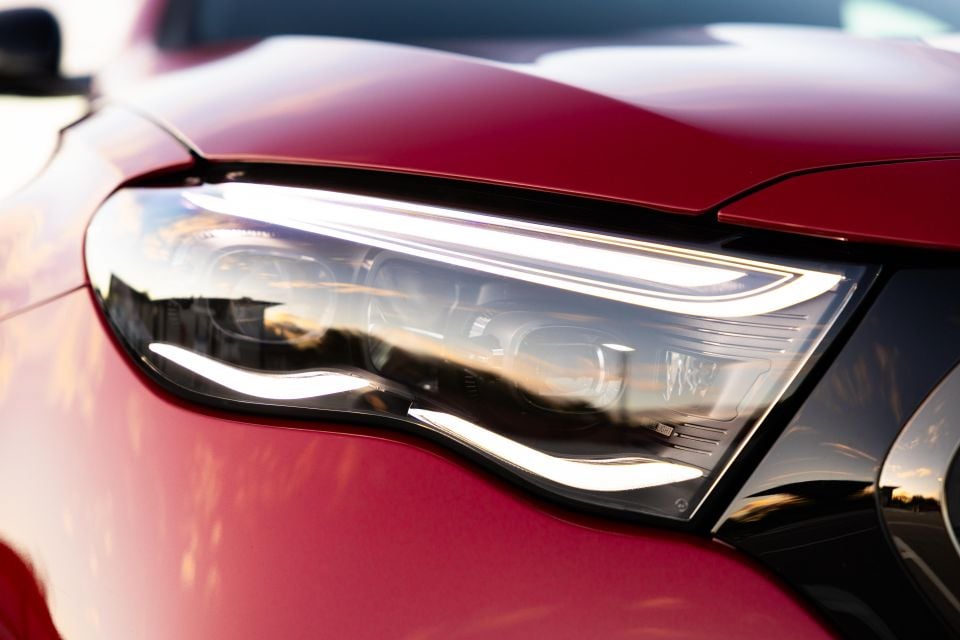

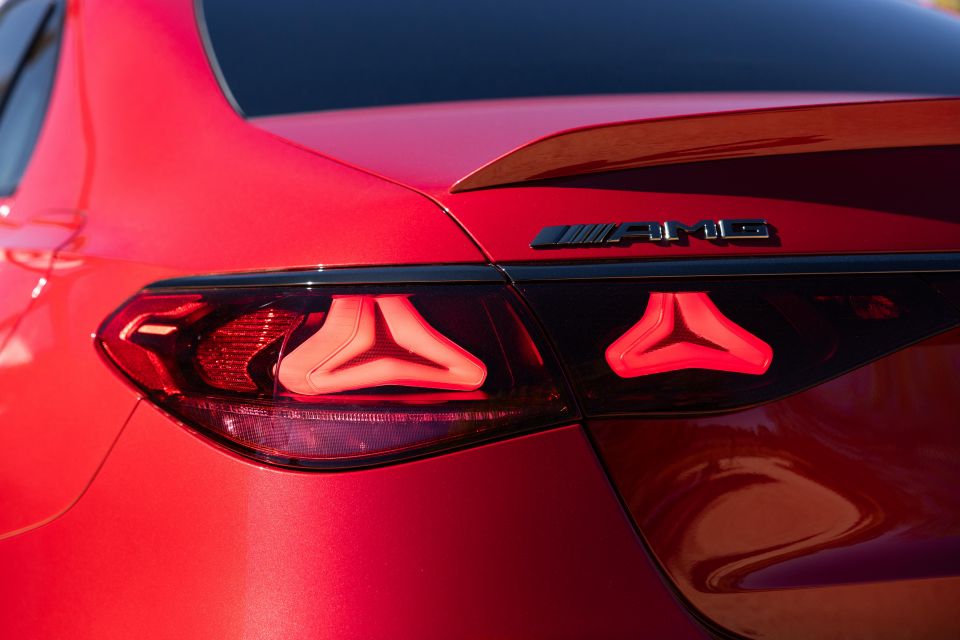

2025 Mercedes-AMG E53 equipment highlights:
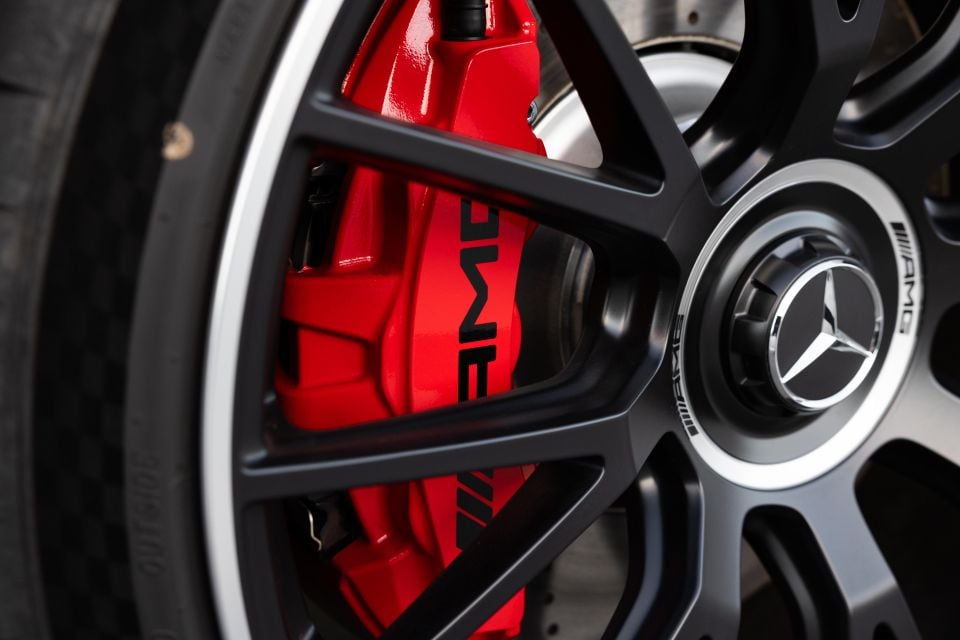
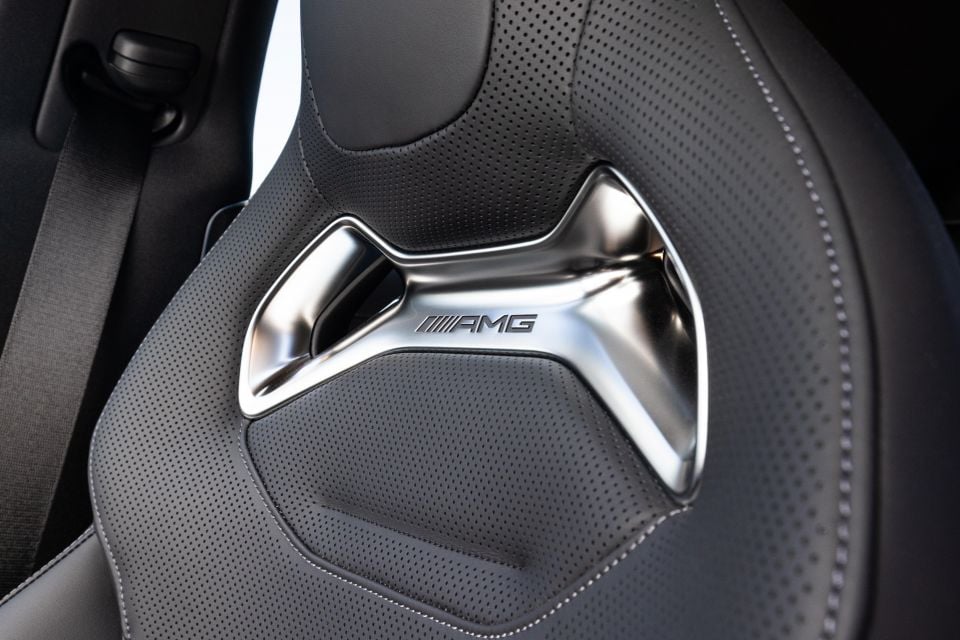
The Night Package ($3000) includes:
The AMG Carbon Fibre Package ($6000) includes:
The AMG Performance Seat Package ($5000) includes:
The Energizing Package Plus ($5300) includes:
To see how the Mercedes-AMG E53 stacks up against its rivals, use our comparison tool
The Mercedes-AMG E53 doesn’t currently have a safety rating from ANCAP, though the Mercedes-Benz E-Class on which it’s based has a five-star rating from sister organisation Euro NCAP.
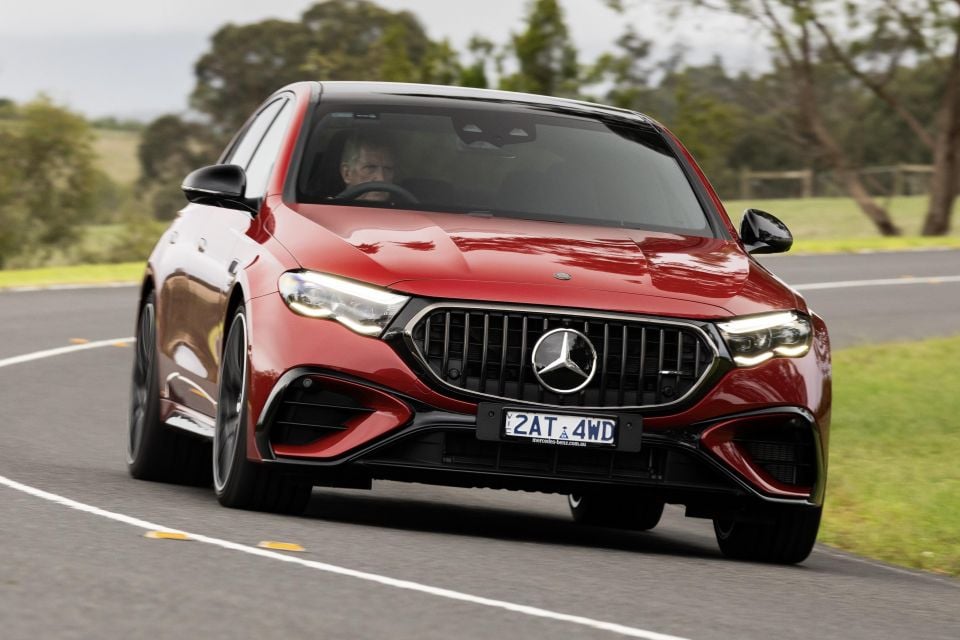
| Category | Mercedes-Benz E-Class (Euro NCAP) |
|---|---|
| Adult occupant protection | 92 per cent |
| Child occupant protection | 90 per cent |
| Vulnerable road user protection | 84 per cent |
| Safety assist | 87 per cent |
Standard safety equipment highlights:
To see how the Mercedes-AMG E53 stacks up against its rivals, use our comparison tool
Mercedes-Benz Australia backs the AMG E53 with its standard five-year, unlimited-kilometre warranty, and an eight-year, 160,000km high-voltage battery warranty. Servicing is required every 12 months or 25,000km, whichever comes first.
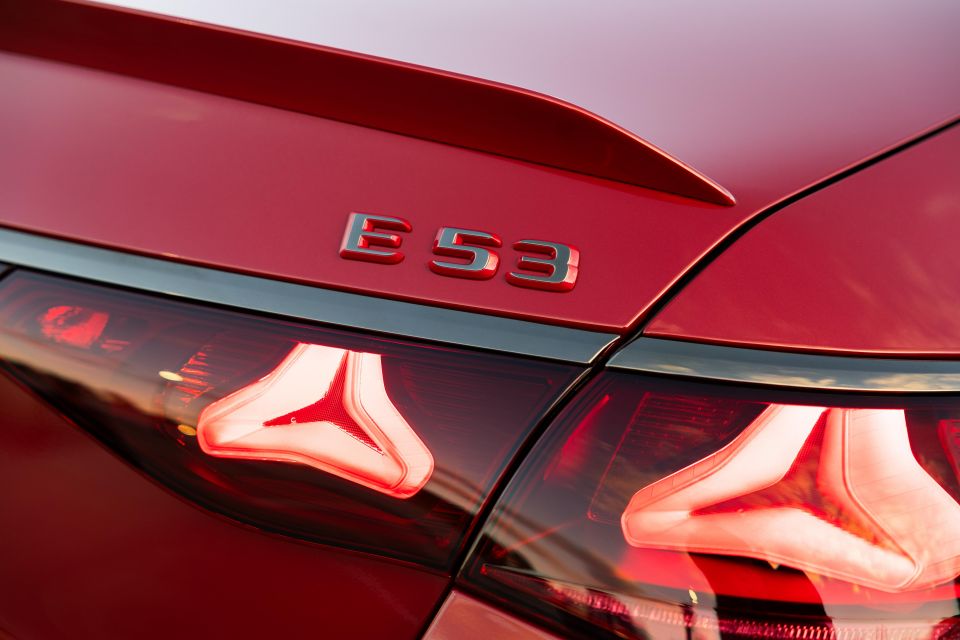
| Servicing and Warranty | 2025 Mercedes-AMG E53 |
|---|---|
| Warranty | 5 years, unlimited kilometres |
| High-voltage battery warranty | 8 years, 160,000km |
| Roadside assistance | 5 years |
| Service intervals | 12 months or 25,000km |
| Service plans | 3 years – $4110 4 years – $5410 5 years – $7570 |
For context, service plans for the standard Mercedes-Benz E-Class cost $3395 for three years, $4675 for four years, and $6945 for five years.
To see how the Mercedes-AMG E53 stacks up against its rivals, use our comparison tool
Buy your new car without the stress. It's fast, simple and completely free.

Great service from Travis and team, second time I have used this business would not hesitate to recommend them to anyone
Craig C.
Purchased a Ford Ranger in Sunshine Coast, QLD
CarExpert helped Craig save $7,224 on his Ford Ranger, now let us save you on your next new car.
Get your BEST priceThe AMG-developed E53 Hybrid marks a significant evolution of E-Class formula, and presents a strong albeit niche new option in the realm of German performance-luxury motoring.
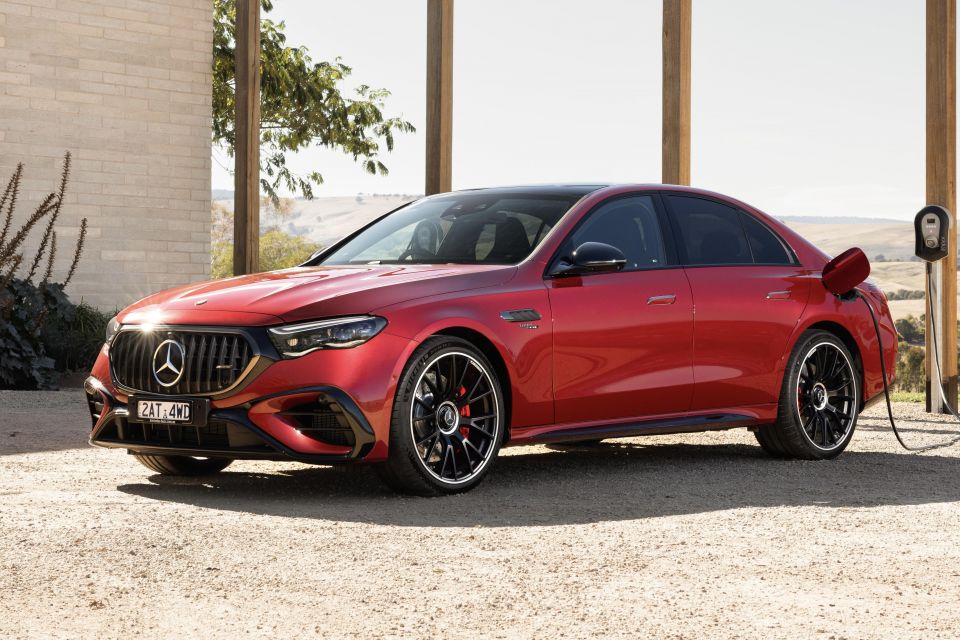
The addition of a beefy PHEV powertrain adds substantial performance and keeps the E53 up-to-date with BMW and Porsche. And even if it doesn’t have the same ‘wow’ factor or outright performance as the M5, it’s hard to argue AMG hasn’t struck a good powertrain balance here.
It’s easy to drive around town, supremely confident on the highway, and opens right up when it’s time to go fast – especially in the context of its only direct competitor in the petrol-only Audi S6.
On top of all that, you can commute long and regularly in EV mode. The generous battery and strong regen braking will allow many to employ only the battery to get them to and from work, and the average E53 could probably spend most of its driving life with its engine switched off by being charged each night.
Of course, however, you wouldn’t buy a $200,000 Mercedes-AMG and let half of its powertrain go to waste, and we’re pretty sure many owners will drive their E53 in a mode that maximises engine performance.
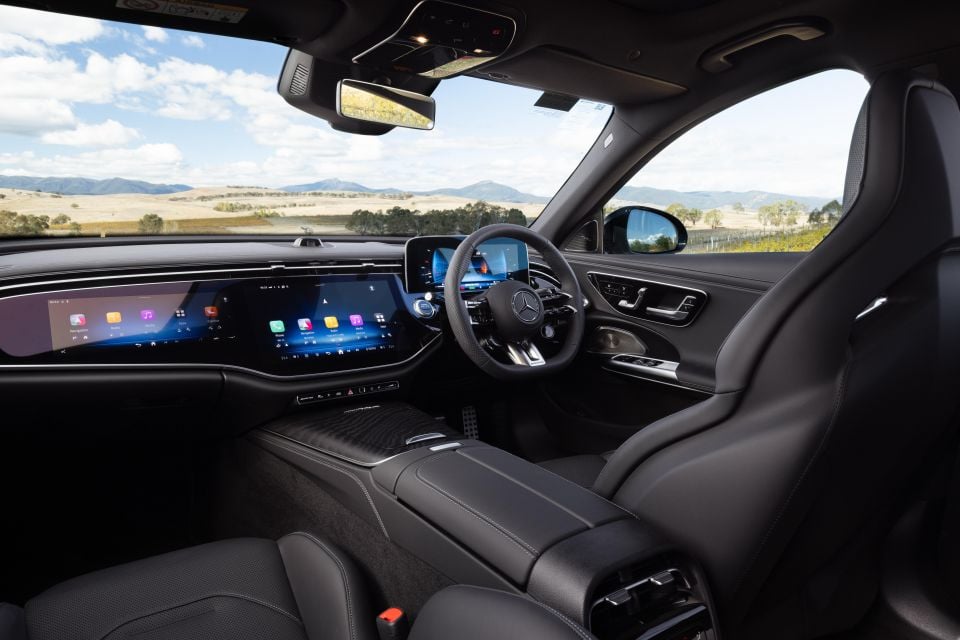
In typical German fashion, this straight-six is exceptionally smooth but always ready to show you what it can do. The V6-powered S6 isn’t too dissimilar, and a PHEV version of the Audi would likely give the E53 a run for its money.
But we can’t help but think the Merc’s interior doesn’t quite do its engineering prowess justice, given it’s practically identical to the standard E-Class. The Superscreen is a little much and lacks the class of the outgoing W213-generation’s cabin.
The E53’s sheer weight is also difficult to ignore, especially for something pitched as a performance car. It’s not that far off the notoriously weighty but much more powerful M5, which means it can’t mitigate its mass in the same way.
Still, it presents a relatively good value option for buyers who doesn’t want to jump all the way to the more extreme M5 or Audi RS6, or a larger Panamera, even if it’s much pricier than the S6.
But if a big, high-performance super sedan wearing the three-pointed star emblem is what you’re after, we suggest biding your time for the next E63.
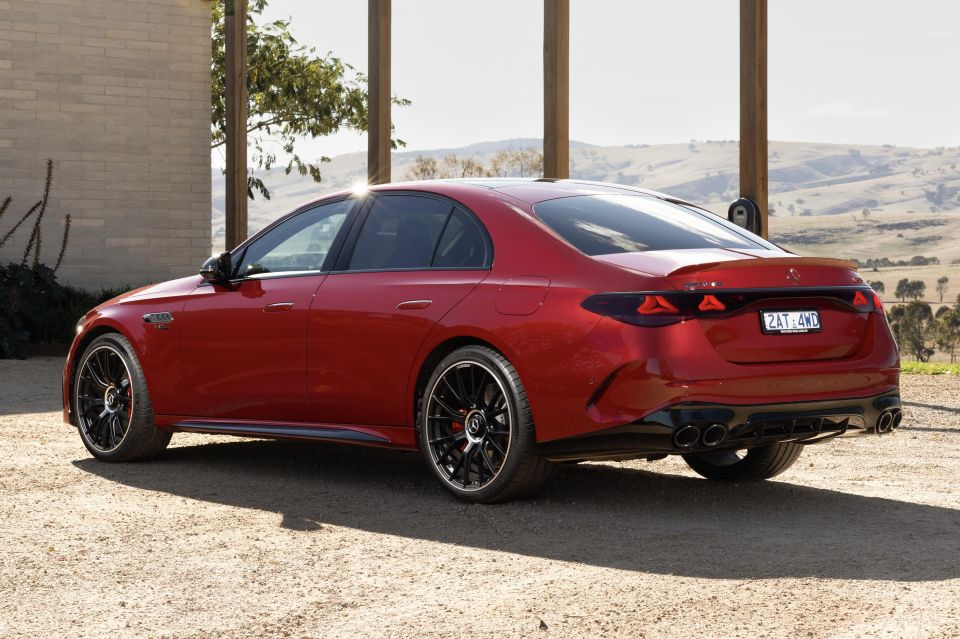
Interested in buying a Mercedes-AMG E53? Get in touch with one of CarExpert’s trusted dealers here
Click the images for the full gallery
Where expert car reviews meet expert car buying – CarExpert gives you trusted advice, personalised service and real savings on your next new car.
Max Davies is an automotive journalist based in Melbourne, Australia. Max studied journalism at La Trobe University and stepped into the automotive world after graduating in late 2023. He grew up in regional Victoria, and with a passion for everything motorsport is a fan of Fernando Alonso.


Andrew Maclean
3 Months Ago
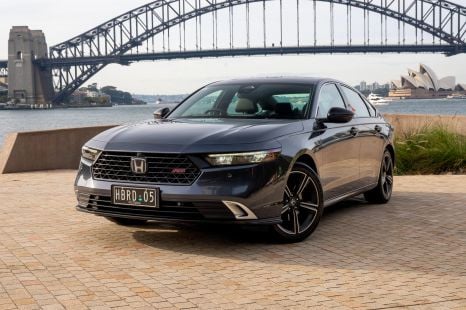

Andrew Maclean
2 Months Ago
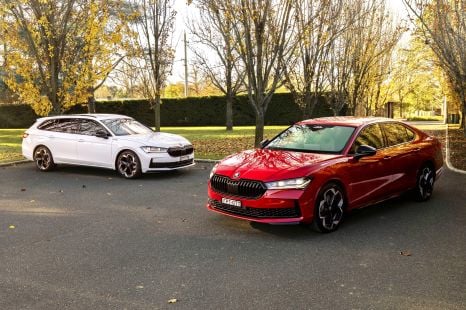

Max Davies
2 Months Ago
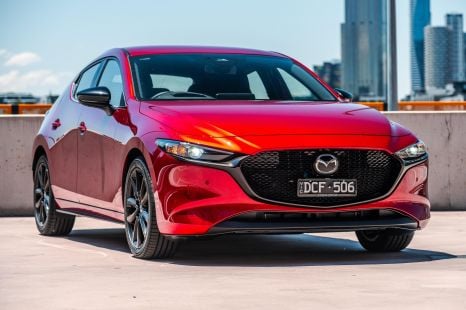

Josh Nevett
2 Months Ago
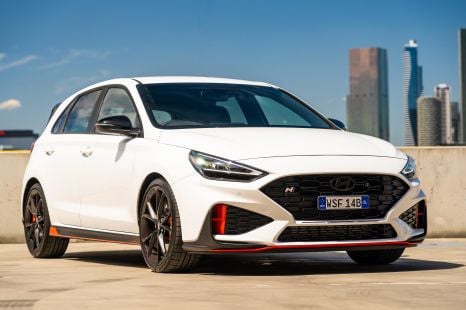

Josh Nevett
2 Months Ago


James Wong
1 Month Ago